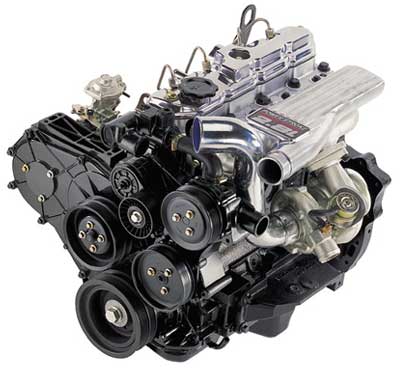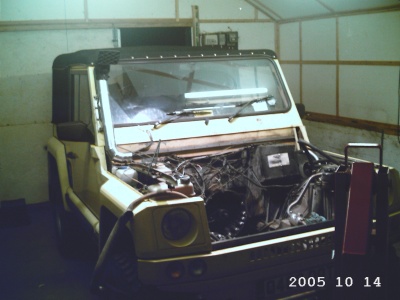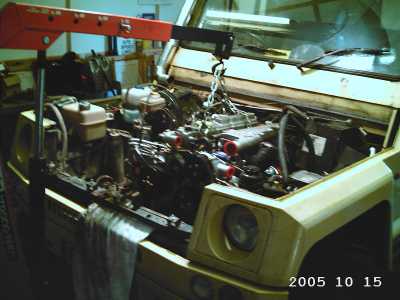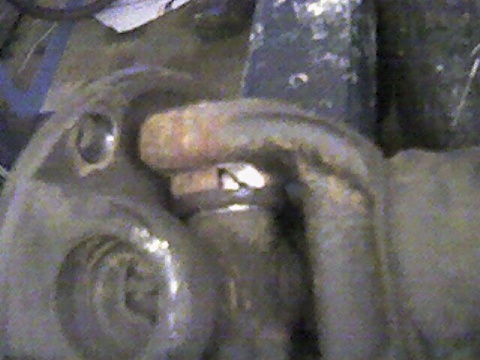For the past 6 months or so, the Ibex has been using a lot of water, with no obvious leaks, or any apparent symptoms. I have been adding more than a pint of water before my morning and evening 50 mile commuter run. With winter coming, the thought continueing to do so while waiting for some fault to become evident seems less and less attractive.
With ongoing problems with the 300Tdi lump, I've been considering a 2.8TGV Powerstroke as an alternative. The 2.8TGV is an updated and redesigned 300tdi engine, with some significant improvements made.
- Head gasket is now laminated steel not composite.
- The crank is forged, not cast.
- The block and head have been redesigned to improve cooling
- The combustion chamber and piston have been redesigned.
- Big ends secured by bolts, and caps are 'fracture fit'.
- Rear crank oil seal improved to stop oil seepage
- A variable nozzle turbo gives higher peak torque at a lower engine speed (277 lb-ft at 1400rpm!) and higher power output (135bhp at 3800rpm)

UK supplier of engines and installation kits M&D Engineering There are no longer any new crate engines available, but M&D continue to supply rebuilt 300tdi engines with TGV internals, as well as many TGV spares.
 Manufacturer of the 2.8 TGV (and also of the last of the 300Tdi engines)
Manufacturer of the 2.8 TGV (and also of the last of the 300Tdi engines)
International Engines (now MWM)
Online : Service manual and Parts Catalogue (Try getting that for free for a 300Tdi !)
A quick look at the dyno curves on the International website shows a mild performance boost over a 300TDi(!)
Prins Maasdijk - Dutch 2.8 TGV supplier. No longer a supplier
With another british winter on the way, I realised that with a suspected cracked or porous head, and inevitably low antifreeze levels due to the constant top-ups, one good cold snap would probably spell the end of the engine. Time to do something about it before it all goes pear shaped.
So, a couple of lengthy chats with M&D Engineering later, I ordered myself a 2.8 TGV engine. The guys were very helpful, talking through the options available and what problems I might encounter fitting their 'Defender' kit into an Ibex. The Ibex engine bay is the same length as a Defender one, and wider, but the bulkhead is a different shape and some components are mounted in different places. The result is that everything seemed like it would be OK, though some additional fabrication and adjustment might be required.
M&D arranged that the engine would be delivered direct to my workshop, and on a day when I could be available to receive it. After discussions, I also ordered M&Ds high capacity radiator (I needed a new rad anyway) and a 'high clamp' clutch kit. I've read in several places that the standard Defender clutch is not considered up to coping with 50% additional torque, and I always consider fitting a new clutch whenever I have an engine out, because of the effort involved in pulling an engine just to change a clutch later.
 Just a small box then :-)
Just a small box then :-)
Unpacking the crate with some exitement, revealed a shiny new 2.8 TGV engine, installation kit, radiator, clutch kit and a fairly large set of instructions. Everything was well packed and labelled and a comprehensive packing list included. My only criticism would be that it wasn't immediately obvious which parts were already fitted to the engine, and so not found in the install kit (oil filter adapter, flywheel housing etc.). The installation sheet was not a set of 'instructions' as such, but a set of tips and pointers - reasonable when anyone trying such a conversion will probably have at least some experience taking engines in and out of vehicles. There was some confusion over some out-of-date information in the sheets, regarding the flywheel housing and a required modification, but a quick phone call back to M&D cleared up the misunderstanding in a few minutes.

The real thing - a 'crate' engine
After studying the paperwork for a while over a coffee, I set to stripping the Ibex. At least, that was the plan... in fact I spent the next hour or so wrestling with a hybrid with a two flat batteries, and a workshop spare that despite being on charge for a week struggled to turn over a new leaf. If I were animistic about my Landies I would think the thing was jealous, especially since it is currently sadly neglected, having only 2WD, a siezed handbrake, and no MoT or tax. Next project, next project...

Too late to turn back now!
With some help from good friend Nick, the engine was out 9pm, wiring labelled, tea drunk and plans discussed. A good point to break for a pint and avoid the common 'OMG it's 3am again' syndrome.
Next morning, bright and early I set about installing the new engine. Some parts have to be swapped from the old engine, and some needed to be modified.
The original 300tdi engine mounts are reused, but the RHS one has the rear stay cut off as it would foul the dipstick tube. A replacement steady bar is supplied in the installation kit.
The original starter motor is reused. This was a major plus in my mind, as a failed starter is a major PITA, and tdi ones are easily available.
The 300tdi air filter mount is reused. M&D suggest bending two of the injector pipes to clear the bracket, but I modified the bracket instead.
With most parts swapped over, I took the opportunity to replace my suspect clutch master cylinder while the engine was out. Of course this turned out to be more troublesome than expected, and several hours were wasted sorting it out. Since the exhaust pipe runs a little differently on the 2.8, I decided to replace the battery to starter cable at the same time, in order to re-route it away from the hot exhaust pipe. As a precaution, I added some heat shielding also. The turbocharger on the 2.8 engine is much larger, and also mounted in the opposite orientation to the 300tdi. The exhaust exits the turbo towards the rear of the engine, and the M&D supplied exhaust drops down behind the LH engine mount, alongside the starter motor. The 2.8 exhaust is not problematic at all, I just took some extra precautions as my starter cable was very stiff and awkward to reroute.
With these tasks complete, I put the engine onto the hoist, and lowered it into the engine bay. Initially I had some problems mating the engine to the gearbox. This always seems difficult the first time with any engine, but the second time it always seems much easier, when the tricks are learnt and the weight and balance of the engine is understood. After a couple of tries without success, I lifted the engine clear and removed the engine mounts temporarily. This made it much easier and the engine mated up to the box almost straight away. A few nuts and washers later, I could lift the front of the engine again, and reinstall the engine mounts.
 It's IN :-)
It's IN :-)
The following day was spent reconnecting wiring and the various hoses and pipes around the engine bay. Terminations needed to be changed on the alternator wiring, and some wires extended. Otherwise everything was straightforward on the electrical side. Coolant hoses were simple to reconnect, with adaption parts from the M&D kit. The only modification from the 'standard' kit was to the filler pipe from the coolant expansion bottle, due to its' different position in the Ibex engine bay.
Turbo and intercooler piping likewise was a simple install, except for the pipe from air filter to turbo, across the back of the engine bay. This is a tricky awkward pipe on a standard vehicle, and the 2.8 modifications require that the pipe is lengthened and shortened at various points in order to fit the new inlet pipe position. Judging from the photos on the M&D paperwork, the heater is mounted a centimeters further 'outboard' on a Defender, which meant that the intake pipe tends to press against the heater body (on an Ibex). A little further work is required here, but there are several possible fixes so no real problems are likely.
If you've read this far down the page, what you really want to know is 'what does it go like?'. After priming the diesel system, the engine fired up instantly first time, and idled smoother than any tdi I've ever seen. A quick run around the yard showed it was noticeably torquey with very light throttle, but also revealed a couple of minor water leaks and a diesel leak. These were swiftly dealt with before some more serious road testing. After only 30 miles or so then engine was loosening up noticeably, and the performance improved.The single biggest change over the 300tdi initally was the off-idle torque. Pulling off in a clumsy fashion with a 300tdi usually means a big stumble and bogging down. Dropping the clutch hard, even with no throttle, the HS2.8 just pulls away fairly violently, to the extent I was more worried about breaking the gearbox than stalling the engine ;-) At higher speeds the most obvious difference is the torque backup - climbing a hill with no drop in speed, without moving the throttle or changing down.
More thoughts after some miles...
After around 500 miles I have a few more thoughts and notes about the 2.8 conversion. For starters, some comments in the LR mags mention the 2.8 having poor fuel economy. Over the first couple of tanks of diesel, the consumption has been approximately 28mpg, mostly over fast A roads and long journeys. I think this compares pretty well to the 29-30mpg I normally acheived from my 300Tdi, especially from a new, tight engine, an d I expect it to improve slightly over a few thousand miles.
At speed, the engine sometimes seems a little dissappointing, but I think this is due to a different throttle response to the 300Tdi. The 300 seemed to be 'all over' by 3/4 throttle and there was nothing to be gained by denting the carpet. The 2.8 has a final 'spurt' at high throttle, even though in the current setup I cannot achieve maximum throttle opening. I deliberately am not correcting this until the engine is a little more run-in :-)
Mid-range response is as impressive as on the first test drive, making the truck much more responsive around town. This could become both addictive and expensive in UJs and gearboxes :-O

Careless Torque!
The Ibex has always been hungry for UJs, probably due to high joint angles. I've never had one break up like this before though, and this propshaft is less than six months old. It was probably caused by a clumsy gearchange while driving around with a failed clutch master cylinder.
My Powerstroke ate my Gearbox!
The nylon Tee piece fitted in the cooling system during the conversion seems to weep a little - still need to find (or fabricate) a metal replacement part.
Installation Likes :-)
- Redesigned and improved 300Tdi.
- Performance!
- Well thought out installation kit.
- Top quality installation parts supplied.
- Excellent documentation pack with great diagrams.
- Friendly and helpful telephone support.
Installation Dislikes :-(
- No long vacuum hose supplied. The vacuum pump is on the opposite side of the engine and I dislike joining hoses unnecessarily. Unfortunately in the age of the throwaway car, where Halfords is considered a motor parts store, it seems difficult to buy a length of vacuum hose longer than 1m. I'm sure a decent commercial factor could have come up with the goods, but Merlin Motorsport came up trumps with a length of shiny blue silicone vacuum rated hose by next day delivery.
- Nylon hose 'T' in cooling system - (I once nearly lost a 200tdi due to one of these failing - I will fit steel ASAP if I can obtain one)
- Needing to remove 2 head bolts to fit the air cleaner bracket (understandable but horrible!)
- Cost ( it's not unreasonable, but it's still a lot of dosh!)